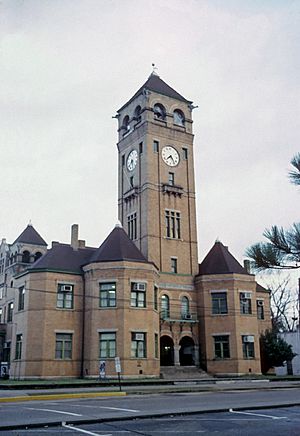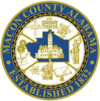Macon County, Alabama facts for kids
Quick facts for kids
Macon County
|
|||
|---|---|---|---|

|
|||
|
|||

Location within the U.S. state of Alabama
|
|||
 Alabama's location within the U.S. |
|||
| Country | |||
| State | |||
| Founded | December 18, 1832 | ||
| Named for | Nathaniel Macon | ||
| Seat | Tuskegee | ||
| Largest city | Tuskegee | ||
| Area | |||
| • Total | 613 sq mi (1,590 km2) | ||
| • Land | 609 sq mi (1,580 km2) | ||
| • Water | 4.3 sq mi (11 km2) 0.7% | ||
| Population
(2020)
|
|||
| • Total | 19,532 | ||
| • Estimate
(2023)
|
18,370 |
||
| • Density | 31.863/sq mi (12.302/km2) | ||
| Time zone | UTC−6 (Central) | ||
| • Summer (DST) | UTC−5 (CDT) | ||
| Congressional district | 3rd | ||
|
|||
Macon County is a county located in the east central part of the U.S. state of Alabama. As of the 2020 census, the population was 19,532. Its county seat is Tuskegee. Its name is in honor of Nathaniel Macon, a member of the United States Senate from North Carolina.
Developed for cotton plantation agriculture in the nineteenth century, the county is considered within the Black Belt of the South. It has had a majority-black population since before the American Civil War.
Contents
History
For thousands of years, this area was inhabited by varying cultures of indigenous peoples. The historic tribes encountered by European explorers were the Creek people, descendants of the Mississippian culture.
Macon County was established by European Americans on December 18, 1832, from land ceded by the Creek, following the US Congress' passage of the Indian Removal Act of 1830. The Creek were removed to Indian Territory west of the Mississippi River. The new settlers brought slaves with them from eastern areas of the South or purchased them at the slave market in Montgomery, New Orleans or Mobile. They developed the county for large cotton plantations.
In the first half of the twentieth century, thousands of African-Americans migrated out of the county to industrial cities in the North and Midwest for job opportunities, and the chance to escape legal segregation. Those who remained have struggled for employment in the mostly rural county, and population has declined by about one-third since 1950.
Before 1983, Macon County was primarily known as the home of historic Tuskegee Institute, now Tuskegee University, and its noted founder and first president, Booker T. Washington.
Geography
According to the United States Census Bureau, the county has a total area of 613 square miles (1,590 km2), of which 609 square miles (1,580 km2) is land and 4.3 square miles (11 km2) (0.7%) is water.
Major highways
 Interstate 85
Interstate 85 U.S. Highway 29
U.S. Highway 29 U.S. Highway 80
U.S. Highway 80 State Route 14
State Route 14 State Route 49
State Route 49 State Route 81
State Route 81 State Route 138
State Route 138 State Route 186
State Route 186 State Route 199
State Route 199 State Route 229
State Route 229
Adjacent counties
- Tallapoosa County (north)
- Lee County (northeast)
- Russell County (southeast)
- Bullock County (south)
- Montgomery County (southwest)
- Elmore County (northwest)
National protected areas
- Tuskegee Airmen National Historic Site
- Tuskegee Institute National Historic Site
- The George Washington Carver Museum
- Tuskegee National Forest
Railroads
- CSX A&WP Subdivision
- Former Seaboard Line (abandoned)
Demographics
| Historical population | |||
|---|---|---|---|
| Census | Pop. | %± | |
| 1840 | 11,247 | — | |
| 1850 | 26,898 | 139.2% | |
| 1860 | 26,802 | −0.4% | |
| 1870 | 17,727 | −33.9% | |
| 1880 | 17,371 | −2.0% | |
| 1890 | 18,439 | 6.1% | |
| 1900 | 23,126 | 25.4% | |
| 1910 | 26,049 | 12.6% | |
| 1920 | 23,561 | −9.6% | |
| 1930 | 27,103 | 15.0% | |
| 1940 | 27,654 | 2.0% | |
| 1950 | 30,561 | 10.5% | |
| 1960 | 26,717 | −12.6% | |
| 1970 | 24,841 | −7.0% | |
| 1980 | 26,829 | 8.0% | |
| 1990 | 24,928 | −7.1% | |
| 2000 | 24,105 | −3.3% | |
| 2010 | 21,452 | −11.0% | |
| 2020 | 19,532 | −9.0% | |
| 2023 (est.) | 18,370 | −14.4% | |
| U.S. Decennial Census 1790–1960 1900–1990 1990–2000 2010–2020 |
|||
2020 Census
| Race / Ethnicity (NH = Non-Hispanic) | Pop 2000 | Pop 2010 | Pop 2020 | % 2000 | % 2010 | % 2020 |
|---|---|---|---|---|---|---|
| White alone (NH) | 3,331 | 3,267 | 3,187 | 13.82% | 15.23% | 16.32% |
| Black or African American alone (NH) | 20,298 | 17,631 | 15,395 | 84.21% | 82.19% | 78.82% |
| Native American or Alaska Native alone (NH) | 39 | 28 | 48 | 0.16% | 0.13% | 0.25% |
| Asian alone (NH) | 91 | 76 | 74 | 0.38% | 0.35% | 0.38% |
| Pacific Islander alone (NH) | 1 | 2 | 4 | 0.00% | 0.01% | 0.02% |
| Other race alone (NH) | 10 | 12 | 45 | 0.04% | 0.06% | 0.23% |
| Mixed race or Multiracial (NH) | 162 | 204 | 418 | 0.67% | 0.95% | 2.14% |
| Hispanic or Latino (any race) | 173 | 232 | 361 | 0.72% | 1.08% | 1.85% |
| Total | 24,105 | 21,452 | 19,532 | 100.00% | 100.00% | 100.00% |
As of the 2020 United States census, there were 19,532 people, 7,474 households, and 4,279 families residing in the county.
2010 census
As of the 2010 United States census, there were 21,452 people living in the county. 82.6% were Black or African American, 15.5% White, 0.4% Asian, 0.1% Native American, 0.3% of some other race and 1.1% of two or more races. 1.1% were Hispanic or Latino (of any race).
Communities
City
- Tuskegee (county seat)
Towns
- Franklin
- Notasulga (partly in Lee County)
- Shorter
Unincorporated communities
- Boromville
- Creek Stand
- Cross Keys
- Fort Davis
- Hardaway
- Little Texas
- Milstead
- Society Hill
- Warriorstand
Places of interest
Macon County is home to the Tuskegee University, a historically black college; Tuskegee National Forest, Tuskegee Lake, the Tuskegee Human and Civil Rights Museum, and Moton Field, the training site of the Tuskegee Airmen.
See also
 In Spanish: Condado de Macon (Alabama) para niños
In Spanish: Condado de Macon (Alabama) para niños



